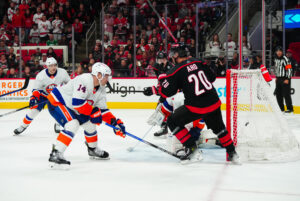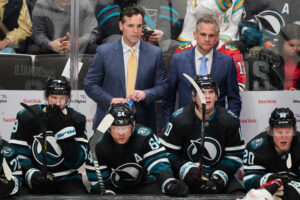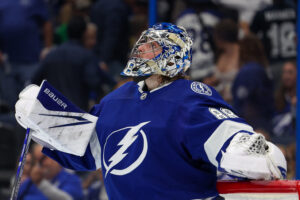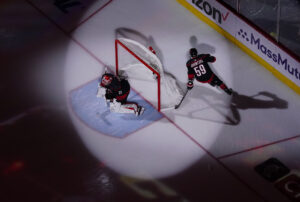Welcome back to Last Word on Hockey’s summer series where we look at the biggest game in team history. Each day we will be back with a new team to look at. Looking at things like the lead-up, what happened, followed, and why it makes it the biggest game. The biggest game does not automatically mean a win, either. Sometimes, it can be a loss that set the franchise back massively. Sit back and enjoy as we break down all 31 teams’ most important game. In this article, Last Word On Hockey editor Christian Holmes will discuss the Toronto Maple Leafs biggest game in franchise history. The full series is found here.
Maple Leafs Biggest Game in Franchise History
In a time before the “William Nylander does not have enough ‘heart'” reality drama and the “is Mitch Marner worth Auston Matthews money” debate existed, an old and gritty Maple Leafs team that would hoist a trophy that has long eluded boys in blue and white sweaters ever since.
This set up what would become arguably the biggest game in Maple Leafs history: Game Six of the 19667 Stanley Cup Final against the Montreal Canadiens. This all during the end of the “Original Six” era.
Yeah, we’re going there. 1967 baby. Canada’s centennial year. The ’60s. Two years before Woodstock. Two years before Nixon and the Americans would fake the moon landing. Rock n’ roll was starting to reach new heights. Sex, drugs, and rock n’ roll, baby! The folks that weren’t into that type of thing loved soul and singin’ the blues. Nixon had become a regular celebrity. “All You Need Is Love” by The Beatles was Canada’s jam. And in Toronto, the hard-workin’, blue-collared folks were in absolute love with George Armstrong and the never-say-die Maple Leafs.
Oh, those were the days, Sunny.
The Leafs story coming into ’67
From the National Hockey League’s inception, the Toronto Maple Leafs (or Arenas or Saint Patricks) have been the poster boys for developing the game. A group of gentlemen a city could rally behind. A young team in the ’40s and ’50s that personified the ideal of the Canadian Dream, giving fans hope for the future after World War ll. An old, hard-working team in the ’60s that embodied the not-so-new idea of the blue-collar lifestyle.
Going into the 1966-67 season, the Leafs were a team on the decline and had a sour taste in their mouth from the previous year’s playoffs where they were swept by the Montreal Canadiens.
According to the Canadian Encyclopedia, “The members of the Leafs that season knew they were flawed. They were mostly old by hockey standards (two were over 40, and six others were 36 or older) and included some erratic personalities. The team lacked scoring punch and had endured a season in which they had lost 10-straight games. It was essentially the same team that the previous year had been swept in the playoffs by the Canadiens.”
The elephant in the room: “Punch” Imlach
Many of the players disliked their general manager George “Punch” Imlach, although he helped the team win a few Stanley Cups earlier in the ‘60s. The players disliked his move to alienate star players like Frank Mahovlich, and most of the promising young players such as Jim Pappin and Pete Stemkowski.
One of the main issues Imlach had with his players was that with the new players’ union starting to take shape and a new collective bargaining agreement coming into place, his players had more control of their dealings with the team. Imlach could not handle his authority being undermined. This led to the friction between the two parties and a precursor for the Harold Ballard Era.
The mid-season meeting
One of the bigger moments in the season was when team captain George Armstrong called a team only meeting on January 20, 1967. This meeting was called to try and rally the troops seven games into their 10-game losing streak. The Leafs went on to lose three more games making them 17-21-8 on the year.
Armstrong, in an attempt to fire up the boys, said to The Toronto Star that “something needs to happen to spark the team.”
Surprise, surprise, the King is back!
After winning a couple of games against the Boston Bruins and Montreal Canadiens, lightning struck. Fate would have it. Head coach “Punch” Imlach would have issues with his heart. As the old saying goes, “The show must go on!”
The team brought on Leafs’ legend King Clancy to coach the team. This was the buzz in town.
The news made The Star’s front page and represented a change in the locker room of the Leafs. They would go onto have a prolonged winning streak. Bringing back their relevance in the Stanley Cup conversation. Although they were not expected to do anything special, even in a league with only five other teams.
The path to the Toronto Maple Leafs biggest game
As the season started to progress into the New Year, the Maple Leafs got better and better with Clancy behind the bench. They were not a powerhouse in the league. That said, for an older group of men, they showed that they still had some life left in them.
The mood in the media reflected that. The team’s succesful play began becoming a regular headline. Toronto Star reporters like Red Burnett were writing stories on how the team’s players felt they could contend for another Stanley Cup.
The ’67 playoffs
The semi-finals
With the Leafs finishing third place in their division, they had to play a tough Chicago Blackhawks team that featured Hall of Fame players such as goalie Glenn Hall, winger Bobby Hull, and centre Stan Mikita.
To make things worse, The Star got word through a Maple Leafs official that Imlach flew the team to Peterborough, Ontario, and put them through a “boot camp” to prepare for the first place Blackhawks.
With hindsight being 20/20, the boot camp may have helped.
The Leafs knocked out Chicago in Game 6 of their semi-final matchup. The media at the time noted just how hard both teams fought over the course of the series. Leafs’ goaltender Terry Sawchuk took a Bobby Hull slapshot to the face in Game 5 but managed to stay in the game and led the Maple Leafs to a 4-3 win.
That meant the team had advanced to the Stanley Cup Final against a familiar foe.
The Stanley Cup Final
In the Stanley Cup Final, the Maple Leafs would face the Montreal Canadiens, a team that swept them in the 1966 playoffs and had won the 1965 and 1966 Stanley Cups. And a team that would not be a pushover. But as the “Nature Boy” Ric Flair would say many years later in 1989, “To be the man, you gotta beat the man, and I’m standing right here!”
The Canadiens were strong down the middle with a trio of Jean Beliveau, Henri Richard and Ralph Backstrom. Their pitfall was rookie goaltender Rogie Vachon. Imlach famously called him a “junior B goalie” when talking to the media in a pre-game scrum.
The series went six games. Each one of those games being a war, even if the score said otherwise. Neither of the teams wanting to give an inch or even a centimetre.
The Leafs lost the first game 6-0. Game 2 they came back and won 3-0. Game 3 went to double overtime and a goal from Bob Pulford would win the game for the Leafs and put Maple Leaf Gardens into a frenzy. Montreal came back and won a nasty Game 4 by a score of 6-2. Pissed as ever and looking for a fight long before Dana White coined the phrase, the Maple Leafs won Game 5 by a score of 4-1.
With that, the Leafs were up in the series 3-2 and coming back home with a chance to make a run for glory.
The Toronto Maple Leafs Biggest Game: Game 6
Then came May 2, 1967. The last time in a long time that Toronto would know what it feels like to be the best of the best in hockey. A feat that they have been chasing ever since.
Coming into Game 6, the Canadiens were on the cusp of elimination and they were desperate. Habs head coach Toe Blake knew and played his lines accordingly. Rolling out the best he had, not because he wanted to, but because had to. Something that one might think Mike Babcock could’ve learned all these years later.
Nevertheless, Game 6 started off physical but both Gump Worsley and Terry Sawchuk kept things scoreless throughout 20 minutes.
Six minutes and 25 seconds into the second period, Ron Ellis scored his second goal of the playoffs to put the Leafs ahead 1-0. In the dying seconds of the second period, Jim Pappin would score his ninth of the playoffs to give the Leafs a 2-0 lead heading into the third period.
Five minutes into the third Dick Duff would score a goal for the Habs, making it 2-1 Toronto with a lot of time left to go in the period. Montreal would keep pushing and pushing but Sawchuk made save after save and kept the puck out of the net. Then with 43 seconds left in the game, captain George Armstrong would put the nail in the coffin of the Habs Stanley Cup hopes and clinch it for the hometown boys.
Toronto ended up winning 3-1 and netting fourth Stanley Cup in six years. And unfortunately the last for the Maple Leafs.
The aftermath
In the years that would follow, generations of Leaf teams would fail to reach the top of the mountain. Bad trades, missed calls, and an owner with a bigger ego than “Long John” Holmes’ firehose would hinder the team’s chances of ever being remotely successful in the post Original Six era.
There were times where Leaf teams came close to glory, but still, no dice. Every generation thinks their story will be different. Unfortunately, it has not. In the present, The Auston Matthews fronted Leafs probably have one of their best rosters in decades and one of the better chances of winning the Cup since ’67.
The Leafs’ faithful are going through hard times. It’s been 52 years and counting. The common folk in Leaf Nation hopes this team, their team, can be the ones to break the chain of loss, failure, and heartbreak. The question is when will the tide of the time be broken and who will be the one to break it? This year? Next year? Your guess is as good as mine.
Main Photo:






